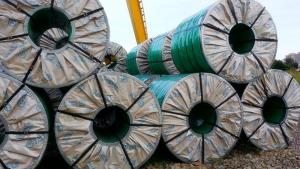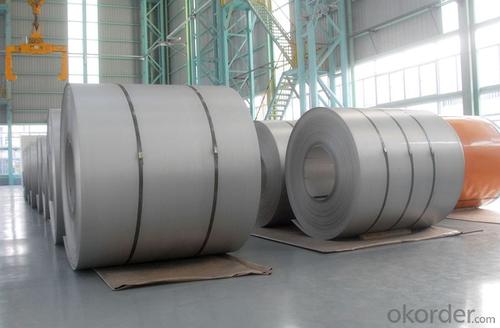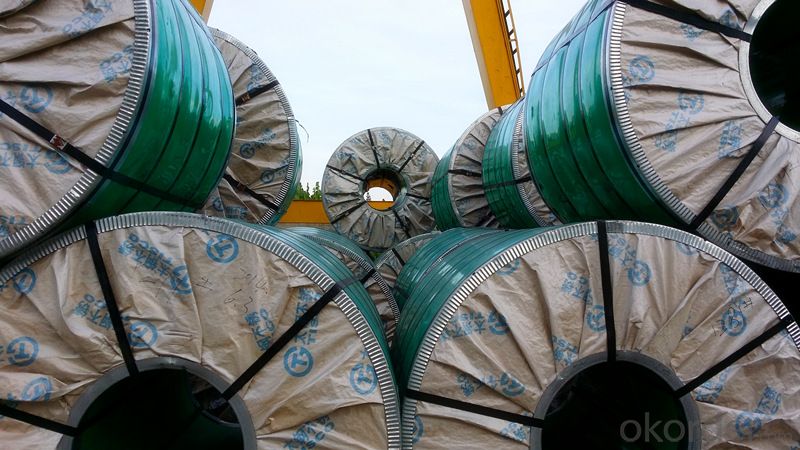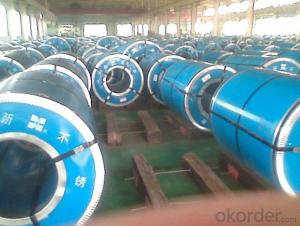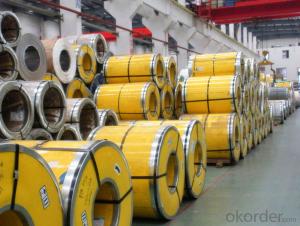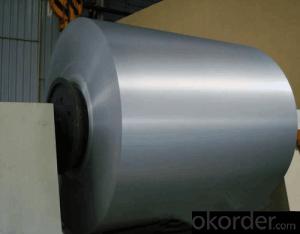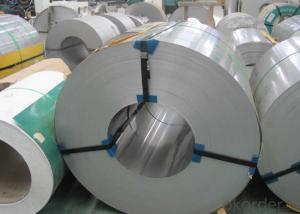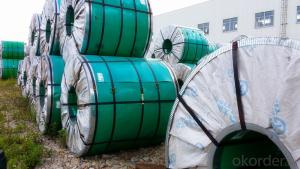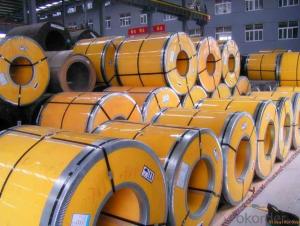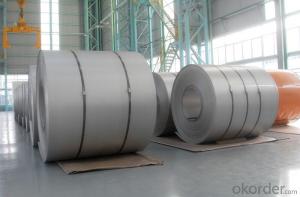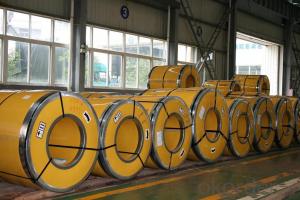Hot Rolled Stainless Steel Coil 430R
- Loading Port:
- Guangzhou
- Payment Terms:
- TT OR LC
- Min Order Qty:
- -
- Supply Capability:
- 10000 m.t./month
OKorder Service Pledge
OKorder Financial Service
You Might Also Like
Grade: | 400 Series | Standard: | JIS,AISI,ASTM,GB,DIN,EN | Length: | Coil |
Thickness: | 2.5mm,3.0mm, 4.0mm | Width: | 1000mm, 1219mm, 1240mm, 1500mm | Place of Origin: | China Mainland |
Brand Name: | CNBM | Model Number: | 430R | Type: | Coil |
Application: | Element Supports,Stove trim rings,Fasteners,Chimney Liners | Certification: | ISO | Certificate: | ISO9001:2008 |
Surface: | No.1 | Technique: | Hot Rolled | Experience: | About 20 years |
Stock Information: | In stock | Weight per coil: | 18-22 tons | Tolerance: | +/-0.1mm or less |
Model No.: | 430R |
|
|
|
|
Hot Rolled Stainless Steel Coil 430R No.1 Finish
Article | Hot Rolled Stainless Steel Coil 430R |
Grade | 400 series |
Specification | 1m, 1.2m, 1.5m |
Surface | No.1 |
Type | Sheet / Coil |
Width | 1000mm, 1219mm, 1240mm, 1500mm |
Thickness | 2.5mm,3.0mm, 4.0mm |
Brand name | CNBM |
Parking | seaworthy wooden pallets or wooden cases,in 20' or 40' container or as per customers' requirements |
Payment | 30% in advance,70% after shipping, or L/C at sight |
Delivery Time | Stock materials, within7-15 days after received the deposit of T/T or L/C |
Hot Rolled Stainless Steel Coil 430R No.1 Finish
Grade | C | Cr | Si | Mn | Mo | Ni | P | S |
| Max |
| Max | Max |
| Max | Max | Max |
430R | 0.12 | 16.0-18.0 | 0.75 | 1.00 | ----- | 0.6 | 0.04 | 0.03 |
- Q: Are stainless steel strips resistant to hydrogen sulfide corrosion?
- Yes, stainless steel strips are generally resistant to hydrogen sulfide corrosion. Stainless steel is known for its excellent corrosion resistance properties, and it is particularly resistant to the corrosive effects of hydrogen sulfide gas. The presence of chromium in stainless steel forms a protective oxide layer on the surface, which acts as a barrier against corrosion. Additionally, stainless steel grades with higher amounts of molybdenum, such as 316 and 904L, offer even greater resistance to hydrogen sulfide corrosion. However, it is important to note that the resistance of stainless steel strips to corrosion can vary depending on the specific grade and environmental conditions. Therefore, it is advisable to consult with a materials engineer or corrosion specialist to determine the most suitable stainless steel grade for a particular application involving hydrogen sulfide exposure.
- Q: How do you prevent discoloration of stainless steel strips?
- One way to prevent discoloration of stainless steel strips is to regularly clean them with a mild detergent and water, followed by thorough drying. Additionally, avoiding exposure to harsh chemicals, such as bleach or ammonia, and abrasive materials can help maintain the integrity and appearance of the stainless steel.
- Q: What are the different types of surface defects in stainless steel strips?
- There are several types of surface defects that can occur in stainless steel strips, including scratches, pits, dents, stains, and discoloration. These defects can occur during manufacturing, handling, or due to environmental factors. It is important to identify and address these defects to ensure the quality and performance of the stainless steel strips.
- Q: What is the thickness range of stainless steel strips?
- The thickness range of stainless steel strips can vary depending on the specific application and requirements. Generally, stainless steel strips are available in thicknesses ranging from 0.02 millimeters to 5 millimeters. However, it is important to note that custom thicknesses can also be manufactured to meet specific needs. The selection of the appropriate thickness depends on factors such as the intended use, structural requirements, and desired aesthetics.
- Q: What are the different types of edge finishes for stainless steel strips?
- Stainless steel strips can be given various edge finishes to improve both their appearance and functionality. Among these options is the straight edge finish, a simple straight cut along the strip's edge. This is commonly utilized in industrial settings where appearance is not a priority. Another frequently used edge finish is the deburred edge, which entails removing any sharp or jagged edges from the strip. This is crucial for safety purposes, as it prevents accidental cuts or injuries. For a more ornamental effect, the rounded edge finish is employed. This involves rounding off the edges of the strip to create a smooth and polished appearance. Often seen in architectural or decorative applications, it imparts a refined and elegant look to the stainless steel strip. Another popular choice is the beveled edge finish, where the edges of the strip are cut at an angle to create a chamfered or sloped edge. This is commonly employed when a seamless transition is required, such as when joining two strips together. Furthermore, there are edge finishes that involve applying a coating or treatment to the edge of the stainless steel strip. This can include the application of a protective film to prevent corrosion or the use of a colored coating for aesthetic purposes. Ultimately, the selection of an edge finish for stainless steel strips depends on the specific requirements of the application, whether it be functionality, safety, or aesthetics.
- Q: Can 111 stainless steel strips be etched or engraved for customization?
- Yes, 111 stainless steel strips can be etched or engraved for customization. Stainless steel is a versatile material that can be easily etched or engraved using various techniques such as chemical etching, laser engraving, or mechanical engraving. These methods allow for precise and detailed customization on the stainless steel strips, providing endless possibilities for personalization or branding purposes. It is important to consult with a professional engraver or etcher to ensure the desired results and to determine the most suitable technique for the specific customization needs.
- Q: What are the common surface finishes for stainless steel strips?
- Common surface finishes for stainless steel strips include mill finish (also known as 2B or BA finish), brushed finish, polished finish, and embossed finish.
- Q: What is the corrosion resistance of stainless steel strips in saltwater?
- In saltwater environments, stainless steel strips exhibit exceptional resistance against corrosion. The presence of a substantial amount of chromium in stainless steel results in the formation of a protective layer of chromium oxide on the surface. This layer acts as a barricade against corrosion and prevents any chemical reaction between the metal and saltwater. Consequently, stainless steel strips possess remarkable resistance to rust and corrosion caused by exposure to saltwater. Moreover, stainless steel is highly resistant to pitting corrosion, a prevalent form of corrosion in saltwater environments. Hence, stainless steel strips find extensive application in marine sectors, such as shipbuilding and offshore structures, where they encounter saltwater conditions.
- Q: What is the elongation of stainless steel strips?
- The elongation of stainless steel strips refers to the ability of the material to stretch or deform without breaking under tension. It is a measure of how much the stainless steel strip can be elongated or stretched before it reaches its breaking point.
- Q: How do stainless steel strips perform in high temperature environments?
- Stainless steel strips are renowned for their exceptional performance in environments with high temperatures. Their outstanding resistance to oxidation and scaling at elevated temperatures is a result of their inherent properties. This can be mainly attributed to the presence of chromium in the steel, which creates a protective oxide layer on the surface when exposed to air, thereby preventing further corrosion. In high temperature environments, stainless steel strips maintain their strength and integrity, rendering them suitable for a wide array of applications. They can endure thermal cycling without significant degradation, ensuring long-term performance and dependability. Furthermore, stainless steel strips exhibit favorable mechanical properties at elevated temperatures, including high tensile and creep strength. This makes them highly desirable for applications involving both high temperatures and mechanical stresses, such as in heat exchangers, furnaces, and automotive components. Moreover, stainless steel strips possess exceptional thermal conductivity, enabling efficient heat transfer and distribution. This is particularly crucial in high temperature environments, as it aids in maintaining consistent temperatures and preventing the occurrence of hot spots or thermal stress. Overall, stainless steel strips have consistently demonstrated their reliability and durability in high temperature environments. Their resistance to corrosion, mechanical strength, and thermal conductivity make them a popular choice across a variety of industries, guaranteeing optimal performance and longevity even under extreme conditions.
Send your message to us
Hot Rolled Stainless Steel Coil 430R
- Loading Port:
- Guangzhou
- Payment Terms:
- TT OR LC
- Min Order Qty:
- -
- Supply Capability:
- 10000 m.t./month
OKorder Service Pledge
OKorder Financial Service
Similar products
Hot products
Hot Searches
Related keywords
